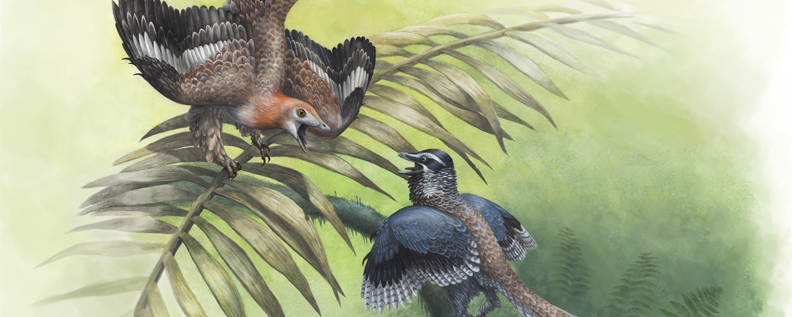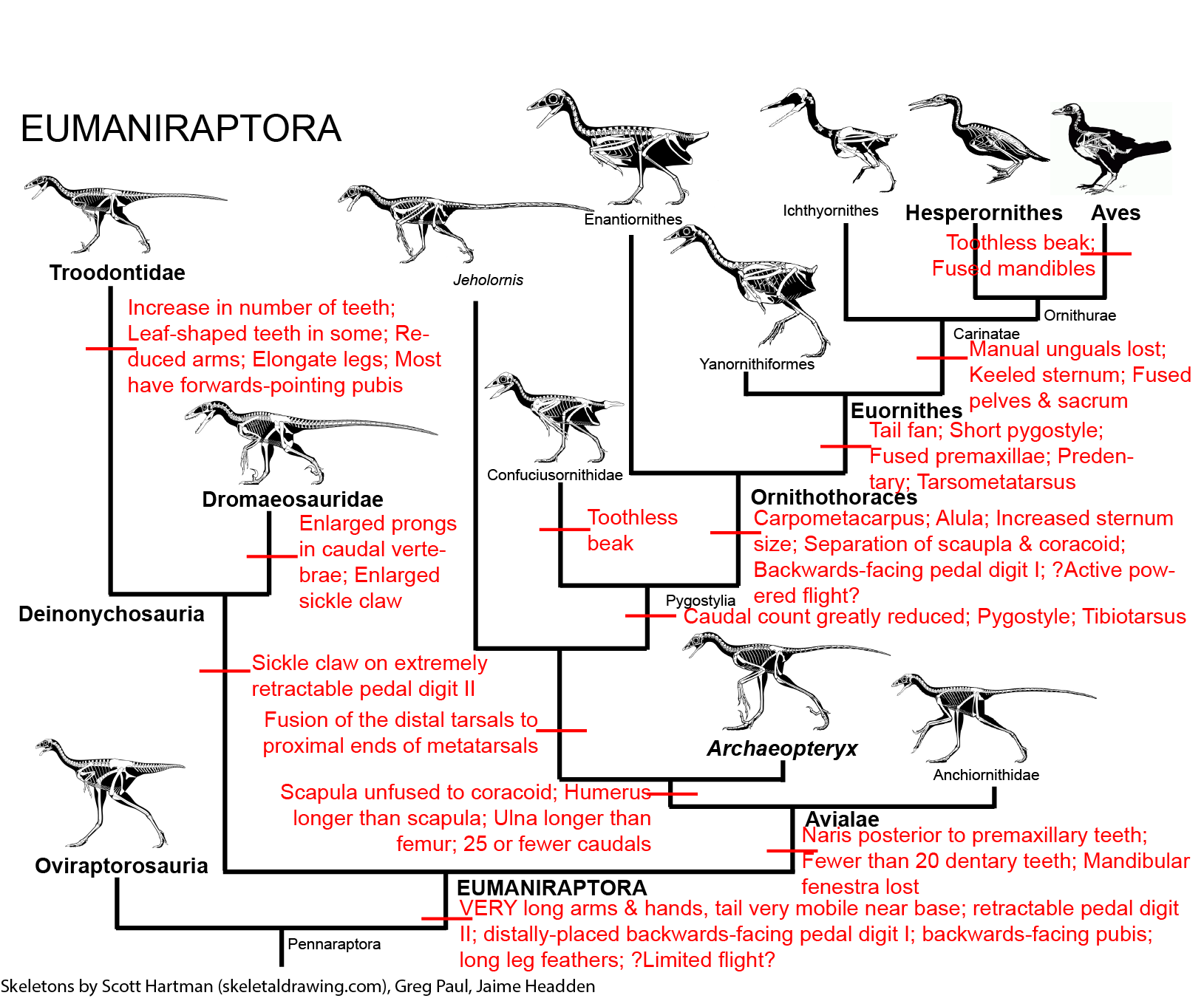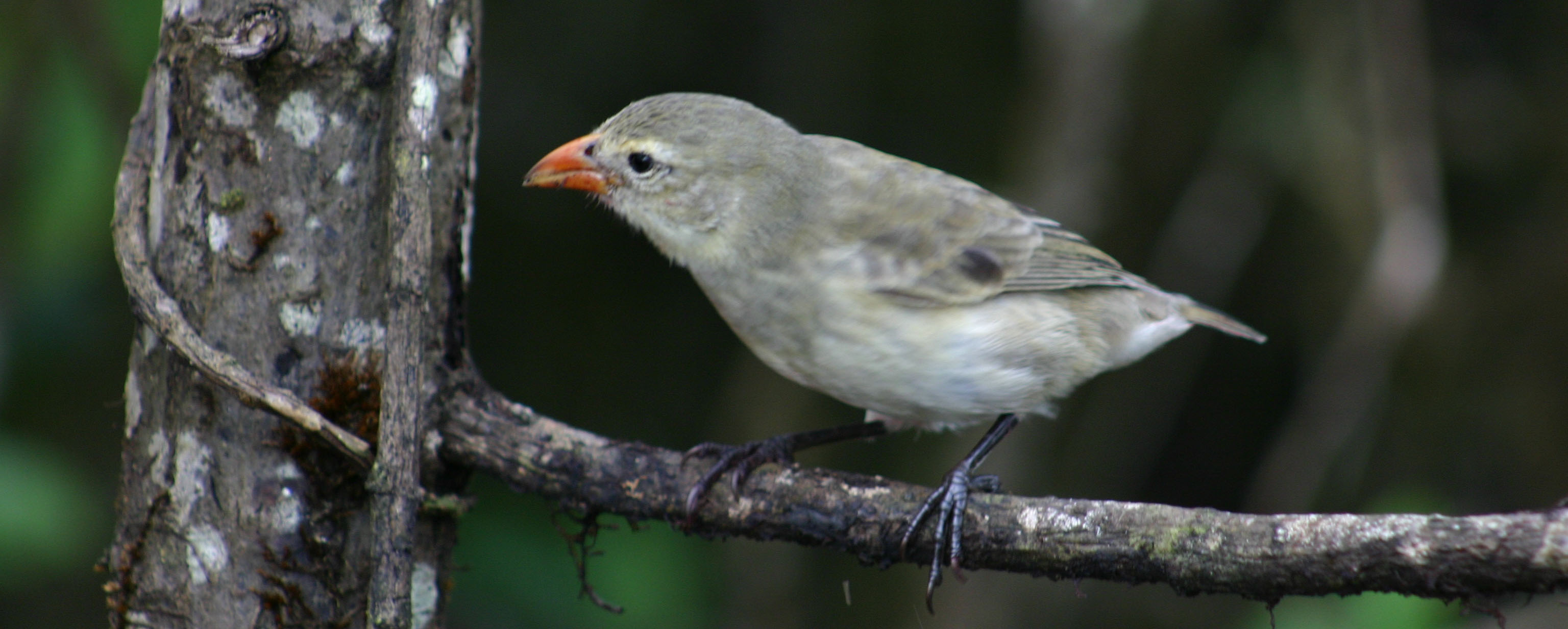


Key Points:
•Avialae is the clade comprised of modern birds and those taxa closer to them than to deinonychosaurs.
•The oldest avialians--such as Jurassic Anchiornis and Archaeopteryx--lacked most of the flight adaptations of modern birds. But over the course of the Cretaceous in stepwise fashion different groups of avialians evolved more sophisticated flying features.

As discussed previously, Eumaniraptora is traditionally divided into two clades: Deinonychosauria and Avialae. However, this situation has become complicated. On the one hand, there are several primitive eumaniraptorans whose exact placement is uncertain. For example, it is uncertain where the late Middle Jurassic (or early Late Jurassic) Pedopenna fits. It might be a basal avialian, or it might be outside Eumaniraptora. Similarly, the scansoriopterygids (discussed last lecture) may be primitive avialians.
In recent years a series new taxa have been found in China which seem to be closer to each other than to all other known taxa. These were once thought to form a clade with Archaeopteryx (Archaeopterygidae), but other studies place them as a clade of basal troodontids. These are the Anchiornithidae. The are best known from the latest Middle Jurassic/earliest Late Jurassic Anchiornis, which shows the presence of long leg feathers as in Archaeopteryx, basal dromaeosaurids, and various basal birds; Xiaotingia; Aurornis; and Eosinopteryx. It has recently been recognized that one "Archaeopteryx" specimen from the Late Jurassic of Germany is actually an anchornithid, given the new name Ostromia. Anchiornithids were first thought to be avialians basal to Archaeopteryx, then to be basal troodontids, then as archaeopterygids, and now back as basalmost avialians.
At present, it appears that the following three alternative positions for these taxa are quite possible, and there is not strong evidence to discount any of these:
One comforting aspect of this uncertainty: the similarity of the morphology of anchiornithids, basal troodontids, microraptorine dromaeosaurids, and Archaeopteryx, shows us what our best model for what the common ancestor of all Eumaniraptora looked like. (Basically, something very similar to Anchiornis and Archaeopteryx.) The basal members of all three clades are crow-sized animals.
Is "Bird" Really the Word?: A note on the use of the word "bird": this English term unfortunately carries with it a lot of intellectual baggage. If we hear that a fossil was from a "bird" we might assume that it had modern "bird" habits and adaptations (flight, song, tree nests, seed or insect diets, etc.). However, not all these characteristics are even true of all modern birds, much less of earlier branches of the lineage. So let's avoid calling Archaeopteryx a "Jurassic bird". There is no evidence that it was a seed eater; there is no evidence for song; it almost certainly nested on the ground; and as we will see it might not have been able to fly any better than early dromaeosaurids.
AVIALAE
The remaining eumaniraptorans are the Avialae ("bird wings"), or "birds, broadly defined". (See note above, though, about the
cautions of using the word "bird" for these early members of the lineage). As the anchiornithids seem to be avialians, this clade is known from the earliest Late Jurassic (or maybe really the latest Middle Jurassic) onward.
The best-studied, and longest-known, basal avialian (indeed, the longest-known Mesozoic eumaniraptoran) is Late Jurassic is Archaeopteryx. Some paleontologists regard this as a single genus and species (A. lithographica); others divide it up into several genera (Archaeornis, Jurapteryx, Wellnhoferia, as well as Archaeopteryx). (For this course, we'll provisionally regard them as a single genus.)
The first and second specimens of this theropod were the first fossil skeletons with feathers ever discovered (in the 1860s and 1870s). Indeed, these were the first good maniraptoran fossils of the Mesozoic ever found. Consequently, Archaeopteryx has spent most of the last century and a half being considered a "bird". But as pennaceous feathers have been found in other theropods, and the skeletons of basal deinonychosaurs have been discovered, the "birdiness" of Archaeopteryx has decreased.
Archaeopteryx came from the Late Jurassic of Europe. Isolated bones from western North America of the same age might be from a same or similar taxon; they may instead be from anchiornithids.
There remain a few features that Archaeopteryx shares with Avialae (modern birds and the theropods closer to birds than to deinonychosaurs), but a new specimen also shows some features more similar to deinonychosaurs than to avialians. So at present, we can't be certain of the position of this little crow-sized dinosaur: indeed, addition of characters from what seem to be its closest relatives have really confused the issue!
With newer specimens and newer analyses, however, anchiornithids have come out as the basalmost avialian. If so, than the traits that unite Avialae are:
While those that unite the clade of Archaeopteryx and more derived avialians are:
Anchiornis is known from literally hundreds, if not thousands, of specimens (rivaling Confuciusornis as the Mesozoic theropod known from the most specimens). Research on this dinosaur is ongoing: it has already revealed phenomenal levels of soft-tissue preservation. As mentioned previously, some of the other small eumaniraptorans from the same quarries (Aurornis, Eosinopteryx, Xiaotingia, and others) may just be specimens of Anchiornis.
Despite some artistic and scientific reconstructions, there is at present no strong evidence that basal avialians were any better at flight than were dromaeosaurids like Microraptor and Rahonavis. Indeed, based on the shape and orientation of the shoulder joints, there is positive evidence that the basal avialians were in fact not very good at powered flight.
Much of our knowledge of the basalmost avialians comes from China. Jeholornis (also called "Shenzhouraptor": both names were proposed within weeks of each other; and another avialian Jixiangornis may also be the same) may be the most primitive avialian other than Archaeopteryx. It was chicken-to-turkey sized, and gut contents show that it ate both seeds and fish. Like the dromaeosaurid Microraptor, Jeholornis had long tail feathers at the end of its tail; however, it also had a cluster of long feathers at the base of the tail.
Bizarre double-sickle-clawed Balaur of Late Cretaceous Transylvania was first thought to be a velociraptorine dromaeosaurid, but new studies place it as a late-surviving long-tailed avialian.
The clade Pygostylia ("pygostyle ones") is comprised of all descendants of the concestor of Confuciusornithidae and modern birds. This group is further transformed from basal avialians by:
(A note on pygostyles: although they are fused in adult birds, even in the modern world embryos and juveniles still have separated bones in the tail. This means when we find fossils without pygostyles it doesn't necessarily mean that they branched off before the origin of this trait: they may simply have been juveniles.)
Phylogenetic relationships among the basal branches of Pygostylia remaining confused at present, and different analyses result in different alternatives.
The Confuciusornithidae of Early Cretaceous eastern Asia are best known from Chinese Confuciusornis. Literally hundreds (if not thousands) of specimens have been discovered, making this crow-sized pygostylian the most common Mesozoic dinosaur fossil. Like modern birds, confuciusornithids had a toothless beak: however, this was convergent with Aves, since the branches between Confuciusornithidae and Aves are all toothed. These may have been at least partially plant- or fruit-eating (they co-occur with the oldest fruit!), but at least some confusiusornithids have fish in their gut contents.
Unlike Aves and their closest kin (together, the clade Euornithes), there was no tail fan in the Confuciusornithidae. Instead, most specimens show no major tail feathers, while others show two very long ones. Perhaps these were sexual signals, or growth indicators, or simply lost in the tail-featherless ones.
The hand of confuciusornithids was still a perfectly good grasping organ.
More derived (in at least some analyses) are the Omnivoropterygidae (sometimes called "Sapeornithidae"), which are the basalmost avialians to show a reduction and fusion of the distalmost caudals into a pygostyle (convergently evovled in the oviraptorosaur Nomingia, therizinosauroid Beipiaosaurus, and the ornithomimosaur Deinocheirus). They have numerous feathers coming off of the pygostyle, but not the sophisticated tail fan of euornithine birds. At present, all known omnivoropterygids are from a single formation (Jiufotang Fm. of China). At least some have stubby blunt teeth at the front of their snouts, suggesting a diet of seeds, fleshy parts of plants, and/or small invertebrates. In some recent studies omnivopterygids were found to be even more basal: more distantly related to modern birds than is Jeholornis. A systematic survey of hundreds of specimens failed to find an ossified sternum on these dinosaurs (the same is true for Anchiornis and for Archaeopteryx).
Another primitive Early Cretaceous pygostylian clade is the Jinguofortisidae. Their hands are more reduced that other typical primitive avialians, but this is convergent with modern birds, as many of the taxa more derived than jinguofortisids have semi-grasping hands.
ORNITHOTHORACES
The remaining pygostylians form the clade Ornithothoraces ("bird chests"). These theropods are further derived in possessing:
The hands of ornithothoracines lacked grasping ability, having become true wings. I think from this point on up the cladogram, it is perverse not to call these animals "birds".
There are two main branches of Ornithothoraces: Enantiornithes and Euornithes.
The "opposite birds", Enantiornithes have a range from the early Early Cretaceous through the end of the Cretaceous. They seem to have been the most diverse and abundant group of birds during their history. Most enantiornithines were toothed. Some may have been insect eaters, some fish eaters, some fruit or seed eaters, and possibly even some meat eaters. The smallest were sparrow-sized; the largest, eagle-sized (and thus the largest flying birds of the Mesozoic). They have been recovered from all over the world, and environments from deserts to shores.
Enantiornithes retained small claws on the manus, but these were greatly reduced compared to earlier avialians. Despite many depictions to the contrary, enantiornithines do not seem to have the tail fan of feathers which characterize modern birds, and at most of a pair of long tail feathers (though rarely as long as those of confuciusornithids).
EUORNITHES
Modern birds and everything closer to them than to Enantiornithes form the clade Euornithes ("true birds": also known as "Ornithuromorpha" or "Ornithuraemorpha"). Transformations relative to basal bird groups include:
Even more derived are the Carinatae ("keeled ones"), characterized by a keeled sternum to support the powerful wing muscles, as well as by 10 or more sacrals, loss of the manual unguals, a synsacrum (fusion of the sacrals together into a sacrum, fusion of the sacrum to the ilium, and fusion of all pelvic elements together), and complete fusion of the premaxillae. A notable Late Cretaceous toothed carinate is Ichthyornis of the seas of the American midwest. (It is worth noting that some studies reverse the order of this: Ichthyornis is closer to Aves than are hesperornithines, and Carinatae is thus within Ornithurae!)
Derived within the carinates are the Ornithurae ("bird tails"), in which the premaxilla makes up the majority of the upper jaw. One (extinct) branch of the ornithurines were the aquatic Hesperornithes (sometimes called "Hesperornithiformes"). Early hesperornithines (such as Early Cretaceous Enaliornis) may have still have had the power of flight, but later ones greatly reduced their wings. In fact, the most specialized forms lost their forearms altogether, with only stumps of humeri for wings. These latter include Hesperornis of the Late Cretaceous of the inland seas of midwestern North America. Even these advanced birds still retained teeth.
The most speciose branch of ornithurines is Aves.
AVES
"Birds" in the strictest sense: the concestor of modern birds and all of its descendants. Aves are distinguished from other carinates
by toothless beaks (convergent with "elaphrosaurs", ornithomimids, oviraptorids, confuciusornithids, and an enantiornithine); the premaxilla makes up almost all of the beak (and thus the maxilla is extremely reduced); dentaries fused to each other (also, the tiny predentary bone is gone), and all bones in the mandible fused to each other; a pneumatic coracoid; the tibiotarsus(see above: fusion of the proximal tarsals to the tibia); 15 or more sacrals; and a number of other skeletal features.
The oldest members of Aves in this restricted sense are from the latest Cretaceous. The major groups of Aves (a clade that today contains 10,000 species, and prior to the Polynesian expansion over the last 2000 years were probably at 12,000 species!) include:
And with Aves, we have finished our review of dinosaurian diversity!
Aves is the only clade of Dinosauria to survive the great extinction.
EVOLUTIONARY PATTERNS IN AVIALAE
Feeding adaptation transformations:
Terrestrial locomotory adaptations:
Miniaturization (and a little Gigantism):
Correlated Progression:
This issue is best dealt with in a later lecture, as one of the main selective forces seems to be that marvelous dinosaurian success story: the conquest of the air!
To Next Lecture.
To Previous Lecture.
To Lecture Notes.
